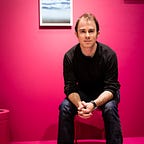Name Your Favorite Artist
“The artist is always engaged in writing a detailed history of the future because she is the only person aware of the nature of the present” — Wyndham Lewis
Most of us can name our favorite bands, or list our favorite songs. We can tell you our favorite films, our favorite directors. We can even name them according to different periods in our lives. We can give you a top ten list of our favorite books, including the last great one that we read. I can tell you what music my parents listened to when I was growing up, and reflect on the influence that might have had on my own taste (I still have that Bonnie Raitt song stuck in my head).
I can’t, however, tell you who my favorite visual artists are, or which artists meant a lot to me in high school. I can’t tell you how my taste has changed over time, or share with you a top ten list of recent favorite artworks. And I don’t think I’m alone.
If you’re not part of the art-collecting few that travel the world visiting art fairs, working with art dealers, buying from galleries, or visiting museums openings, you likely feel disconnected from “the art world.” This is not a surprising outcome for an industry whose primary business models derive value from market scarcity and exclusivity. It’s the very absence of access that makes today’s art businesses work. Think of this: value for an art collector comes at least in part from getting access to something that no one else can have.
Imagine, for a second, if we applied this model to other categories of cultural production like music? Actually, you don’t have to imagine it — we tried it with music and the results were predictably appalling: Wu Tang Clan sold just a single copy of its latest album at auction for millions. Millions of fans were outraged.
Today’s distribution models for visual art have left us disconnected from an entire category of expression that deserves as much of our attention, as much of our fandom, as much of our love and obsession as we offer to music, films, or literature. I don’t know a single artist whose goal it is to distribute their life’s work to a few wealthy collectors on the Upper East Side. That we have in our heads an idea of an “Art World” at all is symbolic of its own brokenness. There is only one world. We all live here. And there should be more art in it.
Art is more than an asset class for investment; it is human expression, and its value should increase when more people experience it.
This is what we wake up every day and try to fix.
Today Electric Objects is three years old.
“What is Electric Objects?” is a question I’ve probably answered over 1,000 times. I’ve probably offered 300 variations, ranging in length from 5 seconds to 5 minutes. I’ve probably left half of the askers confused, and maybe a few inspired.
As we enter our fourth year on this planet, I wanted to try and answer a different question, for myself, for my team, and for the community that has made this company possible. Why are we doing this?
If Electric Objects can do one thing, it can serve as an alternative model for how we discover and engage with art: one that starts from the assumption that we are all capable and deserving of a connection to art and artists, in the same way that we so easily connect with our heroes of music, film, and literature; one that gets better when more people use it.
Today Electric Objects is in thousands of homes across over 30 countries. Over the past year our curators have worked with over 200 artists to create nearly 800 works of art made specifically for the EO platform. And this is just the beginning. In a world where art is as easy to discover and enjoy as a great song, a great film, or a great book, we’re barely scratching the surface of what’s possible.
Next week we’ll announce the next major leap forward for our platform.
The new products we’re introducing next week reflect hundreds of conversations with customers and artists, thousands of hours of engineering and design work, and a few trips to the other side of the world.
Perhaps we can together glimpse into a future in which the art that lives in our homes engages us, inspires us, challenges us, delights us, slows us down, and makes us think; a future in which artists and curators are in the business of reaching more people, not fewer; a future in which a visit to museum is only the beginning of a relationship with that institution; and a future in which the names of our favorite artists are always on our minds.
Perhaps we’ll look back in 10 years and with difficulty, ask ourselves why it wasn’t always like that.
Sign up to be the first to hear about next week’s launch.
Thanks to Nick Chirls, Alex Rosen, Kristina Budelis and the EO team for helping with early drafts.
